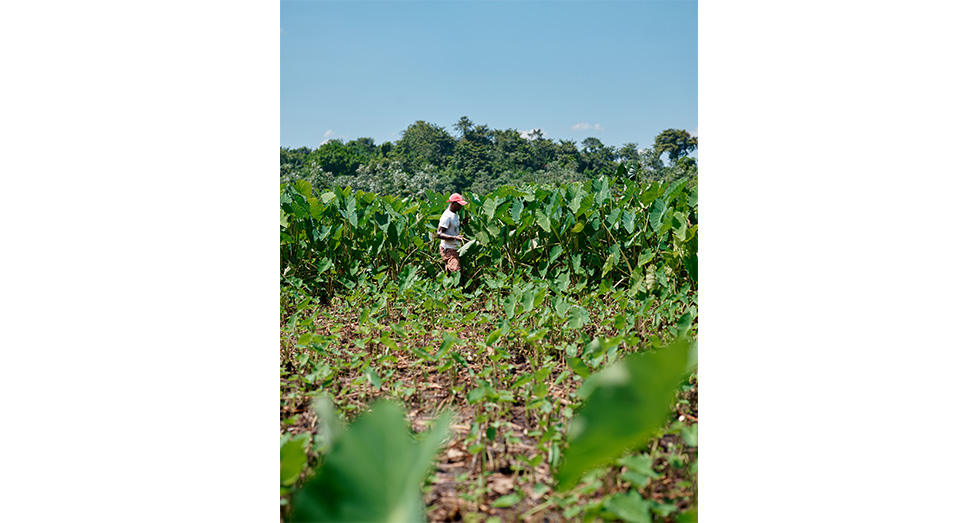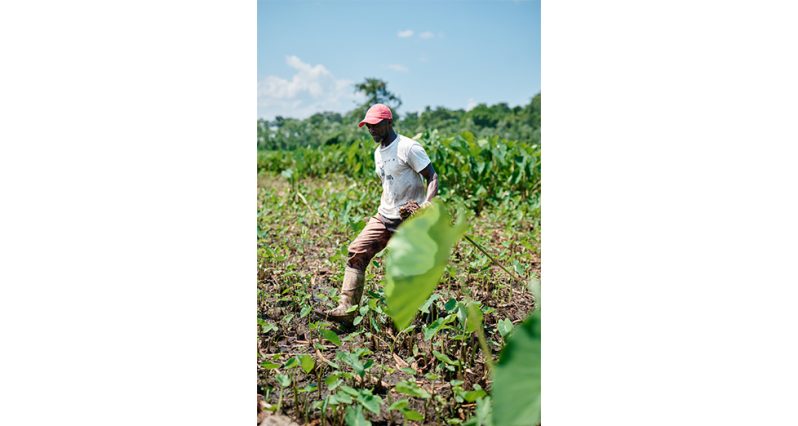- Kuru Kuru eddoe farmer shares the challenges, triumphs, and daily grind behind building his 25-acre farm
WHEN he left the army in 1992, he traded his uniform for a cutlass and faith. Today, more than thirty years later, Justin Bacchus still rises before dawn, working seven days a week on the same 25 acres of land he carved from the dense Kuru Kuru foliage with his bare hands. Through floods, hardship, and hope, Justin has persevered and is now among the largest farmers in his community, often harvesting hundreds of pounds of eddoes. In his interview with Pepperpot Magazine, Justin shared the ups and downs that have shaped his farm’s growth, the hurdles that farmers and the government are trying to overcome, and—despite countless challenges—he says there are very few things he loves more than his farm.
Born and raised along the Berbice River, Justin was no stranger to agriculture. However, rather than venturing into farming like many of his friends and family, Justin became a soldier. His agricultural roots caught up with him in 1992, when he came to Kuru Kuru and saw eddoes being harvested for the first time. “The first time in my life I ever plant eddoe is when I come in Kuku. My brother-in-law had a farm over the next side. He used to plant eddoe, and I used to go and help him plant eddoes and pull eddoe. I said, this is how the farming that I do. I just end up coming away as a soldier and I start cutting.”
Today, Justin’s farm covers some 25 acres, but this growth was slow and marked by dozens of losses and challenges. “When this farm start, is me alone and God start this farm. I chop it down with a cutlass. I didn’t have power saw, so I chop it down with cutlass and axe. The first eddoe I reap was 200 bag of eddoe. I get $14 a pound. I go and I start build my house. And I start establish this farm,” he said. In the years since the farm’s first crop, Justin says it has faced its fair share of losses, with challenges like flooding nearly ending the farm more than once.
Justin says he has been in love with farming since coming to Kuru Kuru, but there are still challenges he and his fellow farmers are working to overcome. One of the main hurdles, he says, is the combination of labour shortages and difficult accessibility. Justin’s farm rests on 25 acres of land, the large majority of which is swamp, needed for the proper cultivation of eddoes. The challenge, however, comes with accessing the swampy farmland, leaving more than 10 acres of eddoes unharvested simply because of its location and the lack of workers willing to venture into the wetlands. “I get 10 acres over a hill. I left 300 bags of eddoe there for rot, because you have to drive around. It is so sad that there is no road. So, the farm just left there, abandoned. Get eddoes, but they cannot pull. Who can bring it out? They can’t bring it out from so far.”

Issues with accessing the farm are a major hurdle in the farm-to-table process and just one of the challenges farmers face. Limited accessibility also increases production costs. “But the only problem now is we don’t have transportation and the road, as you could see, very difficult for the workers, it is already expensive to pay workers on the farm and you got to pay workers extra for farther; it’s rough,” he said. While government intervention would be welcomed, Justin and many of his fellow farmers have carved their own paths through the swamp, creating a unique network of interconnected routes connecting different areas of the farm.
There are no rest days on a farmer’s calendar, according to Justin. Contrary to popular belief, his crops require constant attention. Every day, he follows a simple routine before heading to the farm. “As a farmer, I don’t know where is the rest day. I work each and every day, Sunday to Sunday. Whenever I’m at home, I just focus on my farm because I love farm work. My day is just farming every day. Every day, Sunday to Sunday, I don’t get rest day.” He added, “Every day, since I wake up, say my prayer, I play music and then farm. You come or you call, I get in the farm. Whether snake in the farm, me don’t frighten anything. I pick them up, throw them away, I don’t get angry. Because I love farm work.”
Justin’s love for his farm inspired him to join the community’s farmers’ association. As vice-chairman of the association, he is just one of many farmers in the community working together to solve their issues. “In the farmers’ association, I’m the vice-chairman for it. We get two times every second Wednesday or second Thursday we get a meeting. And we keep the meeting concerning how we’re going to get on with farm and if they have any issues, we try to solve it and so on. This area has a lot of farmers and we have a lot of eddoe farmers too,” he shared.
Agriculture for Justin is more than a job or a means to an end; it is a passionate pursuit to grow quality crops and deliver them to Guyanese homes. But it is also a business. Speaking to other farmers, Justin says the commercial side of farming is often overlooked but is crucial to success, no matter the scale. “For me to advise farmers across the region in Guyana you got to be sustainable. You got to be consistent. You can’t want to pull $50,000 produce and spend $200,000. It’s not profitable. You cannot make it in farming. You have to decide in your mind what’s going to be beneficial to you. This farm here, if I put $10 and produce $20, and I put back $20 and produce $80, the farm is going to grow.” For Justin, farming is a lifelong commitment, a labour of love that connects him to his roots, his community, and the land he has nurtured for more than three decades.


.jpg)











